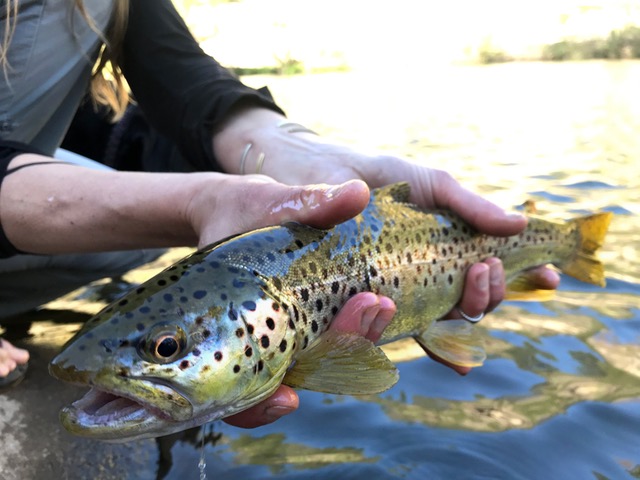What is Dry Dropper?
It has been said that only 10% of a trout’s diet is consumed at the surface, leaving the other 90% subsurface. That is well proven by the fact that a proficient nymph angler can usually catch more fish than a dry fly angler on a given day. Of course, all situations have variables and that last statement can be a bit of a hasty generalization, but one thing is for sure; imitating bugs at both levels will improve an anglers success rate. That is why the dry-dropper, or dry-dropper-dropper method is such an efficient style. Also known as the hopper-dropper, or klink n’ dink, this style of fishing allows the angler to fish flies on the surface, as well as below the surface at the same time.
Another great feature of this method is that it can be fished in virtually any type of water. While an indicator rig is not the greatest option in small pocket water and a euro rig is not great in long slow pools, the dry-dropper works great in both situations. Small streams, big rivers, long riffles, deep pools, and even Stillwater can be fished effectively by hanging a nymph from a dry fly. Furthermore, it seems all too often that fish eats the indicator, so why not put a hook on it? With this method, the dry fly becomes the indicator that will catch fish as well.
Leader Tippet Flies Adding Dropper Casting

Dry Dropper Leader
It may seem trivial, but a good leader will really help the casting and turnover of a dry-dropper rig, especially when fishing big flies such as foam hoppers. The ideal leader will be shorter, about 7.5 feet, and incorporate a shorter forward taper. The long, thick butt section of the leader will force a big fly or bulkier rig to turn over, especially in the wind. Adding tippet to the end of the leader is not mandatory, but the leader taper is short and will be cut down quickly by changing flies. By adding a 12-14 inch section of tippet, the leader will last longer through many fly changes.
Dry Dropper Tippet Lengths
The length between flies should vary for every river based upon the depth and speed of the water, but from the dry fly to the first nymph should generally be about 18 inches at the shortest. That will allow the nymph to drift more freely under the dry fly.
For deeper, or faster water, the tippet length should be longer so that the nymphs reach the fish. Also, the longer tippet will allow the flies to sink and drift more freely for a more natural presentation. Consider running the first nymph upwards of three feet below the dry fly in deep or fast moving water. For small streams and shallow water, the first nymph can be as short as 14 inches below the dry fly to detect quick eats on the nymph in pocket water. Basically, consider the depth fo the water and how much tippet it takes to get the nymph to the bottom of it while keeping in mind that the speed of the current will affect how fast the nymph sinks.
Dry Dropper Flies
It is important to consider the buoyancy of the dry fly compared to the weight of the nymph as the dry fly has become a suspension device in this fishing method. The idea is for the nymph to sink, but the dry fly to float, which can be a fine line to walk.
The nymph itself will need have it’s own weight as adding slit shot is not ideal. For this, choosing a fly with a beadhead is key, but that bead can be glass, brass, or tungsten. Another option is to have weight incorporated into the body of the fly with lead wire.
The dry fly will need to buoyant enough to hold up some weight variation of the nymph, so consider a natural material fly or a foam style fly depending on the nymph.
Consider the following rig examples when deciding the flies to fish together:
- Light- A parachute adams with glass beaded or no beaded emerger.
- Medium- A Stimulator with a brass beaded nymph.
- Heavy- A foam hopper with a tungsten-beaded nymph.

How to Add the Dropper-Dropper
Adding a second nymph can be the key to success when fish really aren’t eating the dry fly, as well as the second nymph can be the weight to sink the first nymph. For example, if the fish are eating emergers, a brass or tungsten beaded second fly can be used as the weight to sink the un-weighted emerger. Some variance in length between the two nymphs is essential, but generally, 14-16 inches between them is ideal. Adding an extra nymph to the rig means a more buoyant dry fly is needed too.
How to Cast for Dry Dropper
As more and more elements are added to a rig, it is crucial that the cast is adjusted to accommodate them to avoid tangles. If false casting the dry-dropper or dry-dropper-dropper rig, waiting an extra second in the cast will allow all three flies to unfold and lay out tangle free. A roll cast or water haul can also be used, but will thoroughly soak the dry fly and require more treatment. These two casts should really only be used if fishing bigger foam bodied dry flies that do not absorb water.
